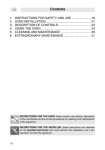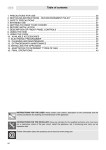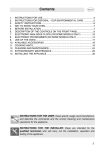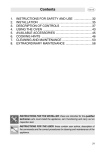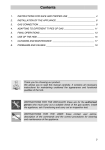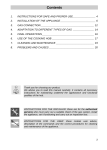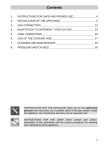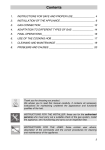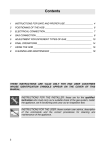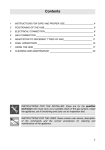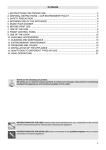Download Smeg MC30RA Instruction Manual
Transcript
Contents 1. 2. 3. 4. PRECAUTIONS FOR USE.................................................................................................................. 28 INSTRUCTIONS FOR DISPOSAL – OUR ENVIRONMENTAL CARE ............................................... 29 SAFETY INSTRUCTIONS................................................................................................................... 30 INTENDED USE OF THE APPLIANCE .............................................................................................. 32 4.1 Examples of outdoor use .............................................................................................................. 32 5. BEFORE INSTALLATION ................................................................................................................... 33 6. INSTALLATION ................................................................................................................................... 34 6.1 Installation on a support................................................................................................................ 34 6.2 Fitted installation (module only) .................................................................................................... 35 6.3 Fitted installation (with barbecue) ................................................................................................. 36 6.4 Fixed installation ........................................................................................................................... 37 6.5 Connection of the appliance to the gas cylinder (liquid gas connection) ...................................... 39 6.6 Check for any gas leaks................................................................................................................ 40 7. ADAPTATION TO DIFFERENT TYPES OF GAS ............................................................................... 41 7.1 Replacing nozzles......................................................................................................................... 41 8. CONNECTING THE APPLIANCE TO THE MAINS SUPPLY (NATURAL GAS CONNECTION) ........................................................................................................ 42 8.1 Burner, nozzle and gas consumption characteristics.................................................................... 43 9. FINAL OPERATIONS FOR GAS APPLIANCES ................................................................................. 44 9.1 Adjusting the minimum for town and natural gas .......................................................................... 44 9.2 Adjusting the minimum for liquid gas ............................................................................................ 44 9.3 Lubrication of gas taps.................................................................................................................. 44 10. KNOW YOUR APPLIANCE............................................................................................................... 45 11. THE CONTROL PANEL ................................................................................................................... 46 12. USING THE APPLIANCE................................................................................................................. 47 12.1 Insertion and replacement of the battery .................................................................................... 47 12.2 Positioning the grid ..................................................................................................................... 47 13. USING THE HOB ............................................................................................................................. 48 13.1 Gas hob ...................................................................................................................................... 48 13.2 Practical tips for using the burners.............................................................................................. 48 13.3 Pan diameters............................................................................................................................. 49 14. CLEANING AND MAINTENANCE .................................................................................................... 50 14.1 Cleaning stainless steel .............................................................................................................. 50 14.2 Cleaning the gas components .................................................................................................... 50 INSTRUCTIONS FOR THE USER: these instructions contain user recommendations, description of the commands and the correct procedures for cleaning and maintenance of the appliance. INSTRUCTIONS FOR THE INSTALLER: these are intended for the qualified technician who must install the appliance, set it functioning and carry out an inspection test. 27 Precautions for use 1. PRECAUTIONS FOR USE THIS MANUAL IS AN INTEGRAL PART OF THE APPLIANCE AND THEREFORE MUST BE KEPT IN ITS ENTIRETY AND IN AN ACCESSIBLE PLACE FOR THE WHOLE WORKING LIFE OF THE APPLIANCE. WE ADVISE READING THIS MANUAL AND ALL THE INSTRUCTIONS THEREIN BEFORE USING THE PRODUCT. INSTALLATION MUST BE CARRIED OUT BY QUALIFIED PERSONNEL IN ACCORDANCE WITH THE REGULATIONS IN FORCE. THIS APPLIANCE IS INTENDED FOR DOMESTIC USE AND IN OPEN ENVIRONMENTS. IT CONFORMS TO THE EEC DIRECTIVES CURRENTLY IN FORCE. THE APPLIANCE HAS BEEN BUILT TO CARRY OUT THE FOLLOWING FUNCTIONS: COOKING AND HEATING-UP OF FOOD; ALL OTHER USES ARE CONSIDERED IMPROPER. THE MANUFACTURER DECLINES ALL RESPONSIBILITY FOR IMPROPER USE. DO NOT USE THIS APPLIANCE FOR HEATING ROOMS. DO NOT DISCARD PACKING IN THE HOME ENVIRONMENT. SEPARATE THE VARIOUS WASTE MATERIALS AND TAKE THEM TO THE NEAREST SPECIAL GARBAGE COLLECTION CENTRE. DO NOT OBSTRUCT THE OPENINGS, THE VENTILATION AND HEAT DISPERSAL SLITS LOCATED ON THE SIDES AND IN THE BOTTOM PART OF THE PRODUCT. THE I.D. PLATE WITH TECHNICAL DATA, SERIAL NUMBER AND BRAND NAME IS POSITIONED VISIBLY ON THE BACK OF THE APPLIANCE. THE PLATE MUST NOT BE REMOVED. NEVER LEAVE THE APPLIANCE UNATTENDED DURING USE. DO NOT USE METALLIC SPONGES OR SHARP SCRAPERS ON THE EXTERNAL SURFACES: THEY WILL DAMAGE THE SURFACES. USE NORMAL NON-ABRASIVE PRODUCTS AND A WOODEN OR PLASTIC TOOL IF NECESSARY. RINSE THOROUGHLY AND DRY WITH A SOFT CLOTH OR DEERSKIN. TO NOT USE WATER JET CLEANERS TO CLEAN THE PRODUCT, SINCE THE POWER OF THE WATER JET MAY CAUSE SERIOUS DAMAGE TO THE SAFETY AND APPEARANCE OF THE PRODUCT. IF THE KNOB BECOMES DIFFICULT TO TURN, YOU ARE ADVISED TO GET THE TAPS INSPECTED BY AN AUTHORISED SERVICE CENTRE. IF THE APPLIANCE IS NOT USED FOR A PERIOD OF TIME, CLOSE THE GAS SUPPLY TAP. IF THE APPLIANCE BREAKS DOWN OR DOES NOT WORK CORRECTLY, PLEASE CONTACT CUSTOMER SERVICE. ALL FAULT REPAIR OPERATIONS MUST BE CARRIED OUT BY AN AUTHORISED SERVICE CENTRE. The manufacturer declines all responsibility for damage to persons or things caused by the nonobservance of the above prescriptions or deriving from tampering with any part of the appliance or by the use of non-original spares. 28 Instructions for disposal 2. INSTRUCTIONS FOR DISPOSAL – OUR ENVIRONMENTAL CARE Our product's packing is made of non-polluting materials, therefore compatible with the environment and recyclable. Please help by disposing of the packing correctly. Find the addresses of collection, recycling and disposal centres from your retailer or from the competent local organisations. Do not throw the packing or any part of it away. They can constitute a suffocation hazard for children, especially the plastic bags. Your old appliance also needs to be disposed of correctly. Important: hand over your appliance to the local agency authorised for the collection of household appliances no longer in use. Correct disposal means intelligent recycling of valuable materials. Pursuant to Directives 2002/95/EC, 2002/96/EC and 2003/108/EC relating to the reduction of the use of hazardous substances in electrical and electronic appliances, as well as to the disposal of refuse. The crossed out bin symbol on the appliance indicates that the product, at the end of its useful life, must be collected separately from other refuse. Therefore, the user must consign the product that has reached the end of its working life to the appropriate differentiated collection centres for electrical and electronic refuse, or deliver it back to the retailer when purchasing an equivalent product, on a one for one basis. Adequate differentiated collection for the subsequent forwarding of the decommissioned product to recycling, treatment and ecologically compatible disposal contributes to avoiding possible negative effects on the environment and on health and promotes the recycling of the materials of which the appliance consists. The illicit disposal of the product by the user results in the application of administrative sanctions. 29 Safety instructions 3. SAFETY INSTRUCTIONS REFER TO THE INSTALLATION INSTRUCTIONS FOR THE SAFETY REGULATIONS FOR ELECTRIC OR GAS APPLIANCES AND VENTILATION FUNCTIONS. IN YOUR INTERESTS AND FOR YOUR SAFETY IT HAS BEEN ESTABLISHED BY LAW THAT THE INSTALLATION AND SERVICING OF ALL ELECTRICAL APPLIANCES IS TO BE CARRIED OUT BY QUALIFIED PERSONNEL IN ACCORDANCE WITH THE REGULATIONS IN FORCE. OUR REGULAR INSTALLERS GUARANTEE A SATISFACTORY JOB. GAS OR ELECTRIC APPLIANCES MUST ALWAYS BE DISCONNECTED BY SUITABLY SKILLED PEOPLE. BEFORE THE APPLIANCE IS PUT INTO OPERATION, THE PROTECTIVE FILMS APPLIED INSIDE OR OUTSIDE MUST BE REMOVED. IMMEDIATELY AFTER INSTALLATION, CARRY OUT A QUICK TEST ON THE APPLIANCE FOLLOWING THE INSTRUCTIONS PROVIDED LATER IN THIS MANUAL. SHOULD THE APPLIANCE NOT FUNCTION CALL THE NEAREST TECHNICAL ASSISTANCE CENTRE. NEVER ATTEMPT TO REPAIR THE APPLIANCE. THIS PRODUCT IS FACTORY SET FOR THE USE OF LPG GAS SOLD IN APPROPRIATE CYLINDERS AT AUTHORISED CENTRES. SHOULD IT BE NECESSARY TO USE A DIFFERENT TYPE OF GAS, YOU MUST CONTACT THE NEAREST AUTHORISED SERVICE CENTRE. A GAS CYLINDER, EVEN IF IT APPEARS TO BE EMPTY, MUST ALWAYS BE HANDLED WITH CARE AND IN COMPLIANCE WITH THE SAFETY RULES PROVIDED WITH THE INSTRUCTION. NEVER USE GAS CYLINDERS WITH DENTS OR RUSTED ZONES. NEVER USE A FLAME TO CHECK THAT GAS IS FLOWING CORRECTLY OUT OF THE BURNERS, OR TO SEARCH FOR ANY GAS LEAKS IN THE APPLIANCE. DO NOT KEEP A SPARE CYLINDER IN THE VICINITY OF THE APPLIANCE. NEVER DISCONNECT THE CYLINDER FROM THE PRODUCT WHILE THE PRODUCT IS FUNCTIONING AND IN ANY CASE ALWAYS KEEP AT A DISTANCE FROM THE PRODUCT FOR ANY OPERATION INVOLVING THE CYLINDER. NEVER PLACE PANS OR CONTAINERS WITH BOTTOMS WHICH ARE NOT PERFECTLY FLAT AND SMOOTH ON THE HOB GRIDS. THE APPLIANCE BECOMES VERY HOT DURING USE. OVEN GLOVES SHOULD BE WORN IN ORDER TO AVOID BURNS. NEVER USE PANS OR GRIDDLE PLATES WHICH PROJECT BEYOND THE OUTSIDE EDGE OF THE HOB. NEVER REST INFLAMMABLE OBJECTS ON THE PRODUCT: IF IT SHOULD ACCIDENTALLY BE SWITCHED ON, THIS MIGHT CAUSE A FIRE. DURING USE THE APPLIANCE BECOMES VERY HOT. TAKE CARE NEVER TO TOUCH THE HEATING ELEMENTS INSIDE THE APPLIANCE. THE APPLIANCE IS DESIGNED FOR USE BY ADULTS. DO NOT ALLOW CHILDREN TO GO NEAR IT OR PLAY WITH IT. WHEN THE PRODUCT IS FUNCTIONING IT MAY BECOME VERY HOT: KEEP CHILDREN AWAY. ALWAYS CHECK THAT THE CONTROL KNOBS ARE IN THE (OFF) POSITION WHEN YOU FINISH USING THE APPLIANCE. 30 Safety instructions FOR CONNECTION TO THE GAS CYLINDER, USE ONLY THE APPROPRIATE CONNECTORS AND REGULATORS AVAILABLE ON REQUEST. THESE PRODUCTS ARE ALSO AVAILABLE FROM AUTHORISED SERVICE CENTRES. THE USE OF OTHER PRODUCTS COULD SERIOUSLY COMPROMISE THE SAFETY OF THE APPLIANCE. NEVER USE THIS APPLIANCE IN A CLOSED SPACE, CAR, VAN, CAMPER OR CARAVAN. The manufacturer declines all responsibility for damage to persons or things caused by the nonobservance of the above prescriptions or deriving from tampering with any part of the appliance or by the use of non-original spares. 31 Instructions for the User 4. INTENDED USE OF THE APPLIANCE The appliance was designed specifically for domestic outdoor use, and is therefore suitable for cooking and heating food. The appliance was not designed and manufactured for professional use. Smeg declines all responsibility for damage arising from incorrect use of the appliance. THIS APPLIANCE MAY ONLY BE USED OUTDOORS IN THE PRESENCE OF NATURAL VENTILATION, OUTSIDE ANY STAGNANT AREAS, WHERE GAS LEAKS AND COMBUSTION PRODUCTS CAN BE RAPIDLY DISPERSED BY THE WIND AND BY THE NATURAL CONVECTION OF THE AIR. 4.1 Examples of outdoor use Any delimited area in which the appliance is positioned must comply with the following requirements: 32 • An area delimited by walls on all four sides, but with at least one permanent opening on the ground and no roof covering. • Inside a delimited area that includes a roof covering but which has no more than two walls. • With a partial closure that includes a roof covering but no more than two walls with the following restrictions: At least 25% of the total surface area of the wall must be completely open. At least 30% of the remaining surface area is open and not delimited. • In the case of terraces, at least 20% of the total surface areas of the walls, back and front, must be open. Instructions for the User 5. BEFORE INSTALLATION Do not discard packing in the home environment. Separate the various waste materials and take them to the nearest special garbage collection centre. In order to remove all manufacturing residues, it is recommended to clean the appliance. For further information on cleaning see point 14. CLEANING AND MAINTENANCE. Choose carefully the location where the product will be installed: 1 it must not be too dusty: over time, the dust could block the burners making the use of the product hazardous; 2 it must not be too exposed to the wind: during use, an excessively strong wind may compromise the correct operation of the product; 33 Instructions for the installer 6. INSTALLATION The installation of this product can be free-standing, supported on a table/shelf or built in to a masonry/ wooden structure. In all cases the following instructions must be followed. 6.1 Installation on a support The product is supplied with 4 four feet that are already screwed in to the sides of the appliance. Position the product on a flat surface and make sure that it is level by screwing the feet in or out. Never use the product without the appropriate supplied feet screwed correctly as this could compromise the safety of the user and the aesthetic appearance of the product. 34 Instructions for the installer 6.2 Fitted installation (module only) MEASUREMENTS FOR FITTED INSTALLATION FRONT CROSS-SECTION VIEW SIDE CROSS-SECTION VIEW DISTANCE IF SIDE WALL PRESENT DISTANCE IF REAR WALL PRESENT HOLE FOR REAR GAS CONNECTION HOLE FOR GAS CONNECTION IN PRESENCE OF REAR WALL POSSIBLE BOTTOM COMPARTMENT HOLE FOR REAR GAS CONNECTION MODEL MATERIAL HEIGHT MC30RA A 310 mm B 150 mm A 320 mm B 200 mm NOT COMBUSTIBLE COMBUSTIBLE A rubber cap is supplied (A) that must be removed if the appliance is installed on a trolley as illustrated in the figure to the side. If the product is embedded in a masonry compartment do not remove the cap or provide an appropriate means for the outlet. A 35 Instructions for the installer 6.3 Fitted installation (with barbecue) After having aligned the height of the two products using the feet, the module can be installed following the measurements provided and the following instructions: MEASUREMENTS FOR EMBEDDED INSTALLATION OF THE MC30 MODULE + BARBECUE SIDE CROSS-SECTION VIEW FRONT CROSS-SECTION VIEW DISTANCES IF SIDE WALLS PRESENT DISTANCE IF REAR WALL PRESENT HOLE FOR REAR GAS CONNECTION DISTANCES FOR ADDITIONAL AIR INLETS OUTLETS FOR ADDITIONAL AIR INLETS IF PRESENT REAR WALL POSSIBLE LOWER COMPARTMENT PASSAGE FOR LOWER GAS CONNECTION ONLY NON-COMBUSTIBLE MATERIAL Distances less than those indicated can cause risks to the structure and the user. MODELS MATERIAL HEIGHT MC30 + BQ60 MC30 + BQ60 A 910 mm 1210 mm C 150 mm 150 mm B 920 mm 1220 mm C 200 mm 200 mm NOT COMBUSTIBLE COMBUSTIBLE Distances less than those indicated can cause risks to the structure and the user. It is possible reach the gas cylinder through a hole made in the structure (taking care to protect the edge of the hole in order to avoid damaging the gas connection tube). Bring the two products side by side, aligning their heights and depths without leaving any spaces between them. 36 Instructions for the installer 6.4 Fixed installation 6.4.1 Installation of the module on a trolley placed side by side with the barbecue For installation of the module on a trolley placed next to the barbecue, refer to the instructions contained in the relevant installation kit. 37 Instructions for the installer 6.4.2 Possible combinations Figure 1 Figure 2 The module can be combined with the barbecue trolley in two ways: 1. Using an external support, as illustrated in figure 1. This type of attachment can be used in the models with a base of 60 cm and 90 cm. 2. The module can be directly integrated in the barbecue trolley. This type of attachment can be used only in trolleys with a 90 cm base (see figure 2). A plate is supplied with the module for fixing the two products side by side centrally on a 90 cm trolley. 38 Instructions for the installer 6.5 Connection of the appliance to the gas cylinder (liquid gas connection) All the adjustments necessary for the correct operation of the appliance are carried out in the factory with liquid gas (LPG). This appliance is intended for the use of LPG gas sold in special cylinders available from specialised shops. A rubber hose can be purchased equipped with a pressure regulator and connections. The pressure regulator is adjusted in the factory to provide optimum operation of the product. The following drawing shows how to connect the appliance to the gas cylinder using the special pressure reducer. The following drawing shows how to connect the appliance and a barbecue (if there is one) to the gas cylinder using the special pressure reducer. Use only the specific connections, hoses and clamps supplied. 39 Instructions for the installer To connect the appliance on its own, just screw or click the regulator to the gas cylinder, making sure that the sealing gasket is mounted on the reducer (if required in the country of destination). Screw the hose connector A to the gas connection C of the appliance, with the sealing gasket B inserted in between. Connect the hose to the hose connector A using the clamp . If necessary, depending on the diameter of the hose , use the hose connector reducer F, which must be screwed to the hose connector A. To connect 2 appliances, just screw or click the regulator to the gas cylinder, making sure that the sealing gasket is mounted on the reducer (if required in the country of destination). Insert the supplied connector D into the hose tightening it with the special clamp . Screw the hose connector A to the gas connection C of the appliance, with the sealing gasket B inserted in between. Connect the hose to the hose connector A using the clamp . If necessary, depending on the diameter of the hose , use the hose connector reducer F, which must be screwed to the hose connector A. Repeat these operations also for the second appliance. The product is factory set to work with LPG. Should it be necessary to change the type of gas, and therefore the diameter of the nozzles, contact the nearest Authorised Service Centre. The product can be set up to work with NATURAL GAS. Contact the nearest Authorised Service Centre. If operation is not optimal, DO NOT ATTEMPT TO REPAIR THE APPLIANCE, but contact the nearest Authorised Service Centre. For assembling or replacing the hose (periodically check its expiration date), you must refer to the applicable regulations. 6.6 Check for any gas leaks These operations must be carried out when the barbecue is connected for the first time and every time that it is disconnected and reconnected to the gas supply. Once the hose of the gas (LPG) supply module is connected, carry out the following operations: 1 Open the gas valve on the LPG cylinder (or rotate the tap for Natural Gas supply), BUT DO NOT ATTEMPT TO LIGHT THE BURNERS. 2 With gas pressure in the hose, check for possible leaks on all the connections using a soap and water solution. Never use a naked flame to check for leaks. 3 In the event that there is a leak, bubbles will appear on the faulty connection where the gas is escaping. 4 Close the gas tap of the gas cylinder, tighten the leaking connection and then repeat the test. 5 If the gas leak persists, contact the nearest supplier. NEVER USE A FLAME TO DETECT LEAKS. 40 Instructions for the installer 7. ADAPTATION TO DIFFERENT TYPES OF GAS The appliance is preset for natural gas G20 (2H) at a pressure of 20 mbar. In the case of operation with other types of gas the burner nozzles must be changed and the minimum flame adjusted on the gas taps. To change the nozzles, proceed as described below. 7.1 Replacing nozzles 1 Extract the grid and remove all the caps and flame-spreader crowns; 2 Unscrew the burner nozzles with a 7 mm socket wrench; 3 Replace the burner nozzles according to the type of gas to be used (see point “8.1 Burner, nozzle and gas consumption characteristics”). 4 Replace the burners in the correct position. 41 Instructions for the installer 8. CONNECTING THE APPLIANCE TO THE MAINS SUPPLY (NATURAL GAS CONNECTION) Before installation, make sure that the local distribution conditions (nature and pressure of the gas) and the state of regulation of the appliance are compatible. To connect the module to the gas supply, a flexible connection B is required which will enable connection to the gas inlet A. Always place a gasket C between the two connections (Fig.1) and tighten the components with a tightening torque of at most 10 Nm. Fig. 1 Connection to the gas supply network can be made using a rigid copper hose or a flexible steel hose with a continuous wall and in compliance with the guidelines established by the standard UNI-CIG 7129. Once the operation is complete, check the hose fittings for leaks using a soapy solution; never use a flame. For supplying it with other types of gas, see chapter “7. ADAPTATION TO DIFFERENT TYPES OF GAS”. The gas inlet connection is threaded ½” external gas (ISO 228-1). Connection with rigid copper hose: The connection to the gas supply network must be carried out in such a way that it does not cause stresses of any type on the appliance. The connection can be made using the adapter unit D with double cone, always inserting the supplied gasket C in between. Tighten the components with a tightening torque of at most 10 Nm. Connection with flexible steel hose: Use only continuous wall stainless steel hoses that comply with standard UNI-CIG 9891, making sure to always insert the supplied gasket C between the connection B and the flexible hose E. Tighten the components with a tightening torque of at most 10 Nm. Fig. 2 42 Instructions for the installer 8.1 Burner, nozzle and gas consumption characteristics Burner Rated heating capacity (kW) LPG – G30/G31 30/37 mbar Nozzle diameter 1/100 mm By-pass 1/100 mm Reduced capacity (W) Capacity g/h G30 Capacity g/h G31 Auxiliary 1.05 50 30 400 76 75 Rapid 3.0 85 45 800 218 214 Burner Rated heating capacity (kW) NATURAL GAS – G20 20 mbar Nozzle diameter 1/100 mm Reduced capacity (W) Auxiliary 1.05 72 400 Rapid 3.0 115 800 43 Instructions for the installer 9. FINAL OPERATIONS FOR GAS APPLIANCES After making the adjustments described above, reassemble the appliance by following the instructions in point 7.1 Replacing nozzles in reverse order. 9.1 Adjusting the minimum for town and natural gas Light the burner and turn it to the minimum position. Extract the gas tap knob and turn the adjustment screw inside or next to the tap rod (depending on the model) until the correct minimum flame is achieved. Refit the knob and verify that the burner flame is stable (turning the knob rapidly from the maximum to the minimum position the flame must not go out). Repeat the operation on all the gas taps. 9.2 Adjusting the minimum for liquid gas To adjust the minimum with liquid gas, you must tighten the screw inside or next to the tap rod (depending on the model) fully in a clockwise direction. The bypass diameters for each individual burner are shown in the table 8.1 Burner, nozzle and gas consumption characteristics. 9.3 Lubrication of gas taps Over time the gas taps may become difficult to turn and get blocked. Clean them internally and replace the lubrication grease. This operation must be carried out by a specialised technician. 44 Instructions for the User 10. KNOW YOUR APPLIANCE CONTROL PANEL BARBECUE HOLDER COMBINATION GRID HEAT DISPERSAL OPENING AUXILIARY BURNER PAN OUTFLOW BRACKET RAPID BURNER 45 Instructions for the User 11. THE CONTROL PANEL All the appliance's control and monitoring devices are placed together on the front panel. The symbols used are described in the table below. RAPID BURNER ON/OFF KNOB AUXILIARY BURNER ON/OFF KNOB These knobs allow you to light the Auxiliary or Rapid burners. The flame is lit as described in paragraph “13.1.1 Electronic lighting of the burners”. 46 Instructions for the User 12. USING THE APPLIANCE 12.1 Insertion and replacement of the battery Models in this range are equipped with a compartment for a 1.5 V AA battery, which lights the burner igniters. To insert or replace the battery, follow the instructions provided below, referring to the drawing: • • • • • access the battery container through the hole in the back (see drawing); unscrew the cap A; replace the battery B with one of the same type; pay attention to the polarity of the battery (strictly follow the drawing shown at the side); screw the cap A back; Warning: Used batteries may not be dumped in the environment or thrown out with other objects. They must be collected separately and brought to the local company authorised for refuse disposal or disposed of in the specific used battery collection containers. 12.2 Positioning the grid Position the grid in the relevant holder as shown in the figure. 47 Instructions for the User 13. USING THE HOB 13.1 Gas hob Before lighting the hob burners, check that the flame-spreader crowns are correctly in place with their respective burner caps, making sure that the holes A in the flame-spreaders are aligned with the plugs and thermocouples. 13.1.1 Electronic lighting of the burners Next to each knob the corresponding burner is indicated (see “the control panel” on page 46). To light the flame, simply push down and turn the knob in an anti-clockwise direction to the minimum flame setting ( . To adjust the flame, turn the knob to the zone between the maximum ( ) and minimum ) settings. To turn off the burner, turn the knob to the OFF position. If no spark is produced when any of the burner control knobs is pressed, it may be necessary to replace the power battery. For instructions on this operation see paragraph “12.1 Insertion and replacement of the battery”). If the battery is new but no spark is generated, do not attempt to use the appliance and contact the nearest authorised service centre. After lighting, keep the knob pressed down for a few seconds to allow the thermocouple to heat up. The burner may go out when the knob is released: in this case, the thermocouple has not heated up sufficiently. Wait a few moments and repeat the operation keeping the knob pressed for a longer time. This is not necessary on burners that are not equipped with thermocouple. Once the burner is lit, the flame can be adjusted as needed. Always check that the control knobs are in the (off) position when you finish using the hob. If the burners should go out accidentally, after about 20 seconds a safety device will be tripped, cutting off the gas supply, even if the gas tap is open. In this case, turn the knob to the OFF position and wait at least 60 seconds before trying to light the burner again. 13.2 Practical tips for using the burners For better burner efficiency and to minimise gas consumption, use pans with a flat, smooth base and a lid that have a suitable size for the burner, thus avoiding that the flames reach the sides of the pan (see point “13.3 Pan diameters”). Once the contents come to the boil, turn down the flame far enough to prevent the liquid from boiling over. To prevent burns or damage to the hob during cooking, all pans or griddle plates must be placed inside the perimeter of the hob. Take the greatest care when using fats or oils since they may catch fire if overheated. 48 Instructions for the User 13.3 Pan diameters BURNERS 1 Auxiliary 2 Rapid min. and max. Ø (in cm) 12 - 16 18 - 26 Warning: At the end of cooking using pans with aluminium bases you may find white residues on the cast iron pan stands. These residues are usually caused by the pan base rubbing against the pan stand and are difficult to remove with normal cleaning. Using abrasive or excessively aggressive products to clean the pan stand could damage its enamel surface. 49 Instructions for the User 14. CLEANING AND MAINTENANCE NEVER USE A JET OF STEAM FOR CLEANING THE APPLIANCE. 14.1 Cleaning stainless steel To keep stainless steel in good condition it should be cleaned regularly after use. Let it cool first. 14.1.1 Ordinary daily cleaning To clean and preserve the stainless steel surfaces, use only specific products that do not contain abrasives or chlorine-based acids. How to use: pour the product onto a damp cloth and wipe the surface, rinse thoroughly and dry with a soft cloth or deerskin. 14.1.2 Food stains or residues Do not use metallic sponges or sharp scrapers: they will damage the surface. Use ordinary non-abrasive products for steel, with the aid of wooden or plastic utensils if necessary. Rinse thoroughly and dry with a soft cloth or deerskin. 14.2 Cleaning the gas components For easier cleaning the pan stands, burner caps, flame spreader crowns and burners can all be removed; wash them with warm water and a non-abrasive detergent making sure to remove any encrustation and wait until they are perfectly dry. Replace the burner caps on their corresponding crowns, making sure that the slots A are centred with the burner pins B. For correct operation the igniters and thermocouples must always be perfectly clean. Check them frequently and clean them with a damp cloth if necessary. Remove any dry residues with a wooden toothpick or a needle. 14.2.1 The grid For best results it is recommended to clean the grid while it is still warm: using heat-proof gloves scour it using a brush with brass bristles in order to remove any food residues. Complete cleaning of the grid with a degreasing detergent and rinse thoroughly. Continuous contact between the grid and the flame can cause modifications to the to the shine of the steel in those parts exposed to heat. This is a completely natural phenomenon which has no effect on the operation of this component. To limit discolouration of the grid we recommend cleaning it with stainless steel cream and a non-abrasive sponge. The grid can be washed in a dishwasher. After thorough cleaning light the appliance in order to burn off any detergent residues. 50

























